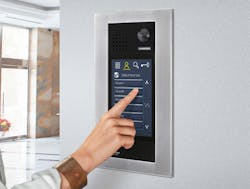This article originally appeared in the November 2020 issue of Security Business magazine. When sharing, don’t forget to mention @SecBusinessMag on Twitter and Security Business magazine on LinkedIn.
The first half of 2020 has brought a number of challenges for facility managers in all sectors. With new health and safety guidelines, multi-tenant facilities must continue to adapt – making now an ideal time for systems integrators to work closely with multi-tenant customers to evaluate existing infrastructures.
COVID-19 has served as a catalyst for increasing customer demand and interest in visitor tenant and monitoring/management. Multi-tenant facilities, such as office buildings and high rises, should be focused on long-term planning and preparing operations for any future health crisis. Beyond simply gaining access to a facility, these areas will be considered high-risk for occupancy management, presenting new challenges in promoting social distancing.
With these considerations in mind, security systems integrators should not only be on the lookout for solutions to help mitigate COVID-19 risks, but search for long-term, sustainable technology for their customers. They should focus on solutions offering a robust number of capabilities, such as remote monitoring, ease of use for tenants, touchless features and the ability to integrate both access control and video.
IP-based intercoms offer managers the ability to remotely access and manage systems from anywhere on the network, offering valuable support. Additionally, intercoms can be placed anywhere access credentials are required, or will be required due to new health and safety regulations, such as gyms, laundry services, elevators and other common spaces. These capabilities will be paramount in multi-tenant facilities of all sizes.
Remote Monitoring
While remote monitoring is not new to the industry, the COVID-19 pandemic only shed more light on its usefulness and efficiency to facility managers. Many multi-tenant facilities have been forced to decrease the number of staff onsite, leading to greater demand on employees who remain. In these cases where less manpower is required, an intercom system with remote monitoring allows calls to be routed to any location – providing additional support when staffing is low. This eliminates excess in-person interactions between staff, visitors and tenants, as the employee is not required to be onsite to handle requests, such as granting access into a mail room for package deliveries.
Remote management can also be used for businesses with multiple locations. For example, an office looking to deploy an intercom system in various multi-tenant or campus locations, can manage access safely from one central, remote station. Network-based intercom systems also eliminate limitations as to where the hardware can be placed. This means that the intercom system can be installed post-construction and placed in a variety of different locations where accessibility is key.
Perimeter Security
Ed Maffey, president of New Jersey-based integrator Maffey’s Security Group, says an IP intercom system can be used inconjunction with new thermographic technology to enable operators to communicate with persons requesting access who might have to follow certain COVID-related protocols. Pairing an intercom with a camera enables communication between the security team and individuals.
“Intercoms have been a critical part of perimeter security for many years; however, in today’s new world, it is paramount that visitors and staff be thoroughly vetted before entering a facility,” Maffey says.
IP intercoms can also feature a touchless operating system that can detect motion within a preset range. Such solutions can be integrated with a door to fully automate the process to create a touchless solution where a door handle would not need to be touched. To eliminate false alarms from non-human movement near the sensor, it can be preset to a range of only a few inches.
“When an individual approaches the sensor field, it triggers a signal for two-way intercom and video communication,” Maffey explains. “The visitor or tenant is not required to touch a button to speak directly with an operator.”
Occupancy Management
For security systems in multi-tenant facilities, it is not enough to hear a person – operators and residents also want to visually confirm identity. This capability is increasing in popularity, as buildings seek to maintain occupancy regulations. For example, if a single person is requesting access to a store, without video there might be 12 additional people entering the building, which would violate COVID-related occupancy restrictions. Additionally, only three of those individuals might have the proper access credentials.
No matter the size of a building, number of tenants or visitors, controlling main access to the building, including limiting access to a variety of other spaces, is the primary goal. Where access control is needed for common spaces, such as laundry facilities, pools or gyms, a video door station will allow the operator to see who is requesting access before unlocking the door.
They can be further integrated with a dome camera, allowing the operator to switch between viewing the entrance and the inside space. This capability offers facilities greater insight into the management of building occupancy, as well as room occupancy numbers. For example, if a gym can only safely allow 10 people inside at a time, an operator can screen each person requesting access, monitor the number of people already inside the room and communicate next steps to the individual.
Additionally, the video intercom systems will allow operators to identify if the individual is wearing proper, required facial protection before granting access – thus enabling building managers to better maintain occupancy policies, social distancing guidelines and any other health and safety requirements in commonly used spaces.
Beyond COVID Protection
Long before the pandemic ushered in a new way of navigating the world, the usefulness of an intercom system offered myriad benefits to multi-tenant facilities. As many facility and security managers can attest, access control cards and other credentials are easily lost or stolen.
Additionally, database management can be that much more cumbersome and painful than alternative systems, while often needing multi-factor authentication to ensure the individual is who they say they are. Video intercoms eliminate the need to rely solely on physical hardware, and along with it, many of these pain points that end-users encounter.
While IP-based video intercoms are generally targeted at large facilities in metropolitan areas, it can also apply to smaller facilities and spaces.
Paul Hefty is a Technical Sales and Support Engineer for Aiphone Corp. Request more info about the company at www.securityinfowatch.com/10212724.



